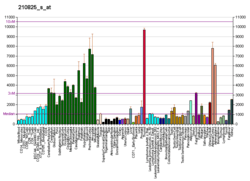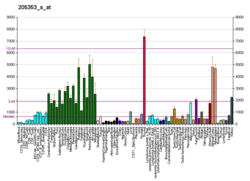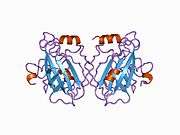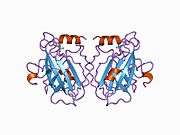Phosphatidylethanolamine binding protein 1
Phosphatidylethanolamine-binding protein 1 is a protein that in humans is encoded by the PEBP1 gene.[5][6]
Interactions
Phosphatidylethanolamine binding protein 1 has been shown to interact with:
References
- 1 2 3 GRCh38: Ensembl release 89: ENSG00000089220 - Ensembl, May 2017
- 1 2 3 GRCm38: Ensembl release 89: ENSMUSG00000032959 - Ensembl, May 2017
- ↑ "Human PubMed Reference:".
- ↑ "Mouse PubMed Reference:".
- ↑ Park S, Yeung ML, Beach S, Shields JM, Yeung KC (May 2005). "RKIP downregulates B-Raf kinase activity in melanoma cancer cells". Oncogene. 24 (21): 3535–40. PMID 15782137. doi:10.1038/sj.onc.1208435.
- ↑ "Entrez Gene: PEBP1 phosphatidylethanolamine binding protein 1".
- 1 2 3 Yeung K, Janosch P, McFerran B, Rose DW, Mischak H, Sedivy JM, Kolch W (May 2000). "Mechanism of suppression of the Raf/MEK/extracellular signal-regulated kinase pathway by the raf kinase inhibitor protein". Mol. Cell. Biol. 20 (9): 3079–85. PMC 85596
 . PMID 10757792. doi:10.1128/mcb.20.9.3079-3085.2000.
. PMID 10757792. doi:10.1128/mcb.20.9.3079-3085.2000.
Further reading
- Schoentgen F, Jollès P (1995). "From structure to function: possible biological roles of a new widespread protein family binding hydrophobic ligands and displaying a nucleotide binding site". FEBS Lett. 369 (1): 22–6. PMID 7641877. doi:10.1016/0014-5793(95)00376-K.
- Ojika K, Mitake S, Tohdoh N, Appel SH, Otsuka Y, Katada E, Matsukawa N (2000). "Hippocampal cholinergic neurostimulating peptides (HCNP)". Prog. Neurobiol. 60 (1): 37–83. PMID 10622376. doi:10.1016/S0301-0082(99)00021-0.
- Odabaei G, Chatterjee D, Jazirehi AR, Goodglick L, Yeung K, Bonavida B (2004). "Raf-1 kinase inhibitor protein: structure, function, regulation of cell signaling, and pivotal role in apoptosis". Adv. Cancer Res. 91: 169–200. PMID 15327891. doi:10.1016/S0065-230X(04)91005-6.
- Hochstrasser DF, Frutiger S, Paquet N, Bairoch A, Ravier F, Pasquali C, Sanchez JC, Tissot JD, Bjellqvist B, Vargas R (1992). "Human liver protein map: a reference database established by microsequencing and gel comparison". Electrophoresis. 13 (12): 992–1001. PMID 1286669. doi:10.1002/elps.11501301201.
- Dawson SJ, White LA (1992). "Treatment of Haemophilus aphrophilus endocarditis with ciprofloxacin". J. Infect. 24 (3): 317–20. PMID 1602151. doi:10.1016/S0163-4453(05)80037-4.
- Tohdoh N, Tojo S, Agui H, Ojika K (1995). "Sequence homology of rat and human HCNP precursor proteins, bovine phosphatidylethanolamine-binding protein and rat 23-kDa protein associated with the opioid-binding protein". Brain Res. Mol. Brain Res. 30 (2): 381–4. PMID 7637590. doi:10.1016/0169-328X(95)00029-R.
- Seddiqi N, Bollengier F, Alliel PM, Périn JP, Bonnet F, Bucquoy S, Jollès P, Schoentgen F (1994). "Amino acid sequence of the Homo sapiens brain 21-23-kDa protein (neuropolypeptide h3), comparison with its counterparts from Rattus norvegicus and Bos taurus species, and expression of its mRNA in different tissues". J. Mol. Evol. 39 (6): 655–60. PMID 7807553. doi:10.1007/BF00160411.
- Maruyama K, Sugano S (1994). "Oligo-capping: a simple method to replace the cap structure of eukaryotic mRNAs with oligoribonucleotides". Gene. 138 (1-2): 171–4. PMID 8125298. doi:10.1016/0378-1119(94)90802-8.
- Hori N, Chae KS, Murakawa K, Matoba R, Fukushima A, Okubo K, Matsubara K (1994). "A human cDNA sequence homologue of bovine phosphatidylethanolamine-binding protein". Gene. 140 (2): 293–4. PMID 8144042. doi:10.1016/0378-1119(94)90562-2.
- Moore C, Perry AC, Love S, Hall L (1996). "Sequence analysis and immunolocalisation of phosphatidylethanolamine binding protein (PBP) in human brain tissue". Brain Res. Mol. Brain Res. 37 (1-2): 74–8. PMID 8738137. doi:10.1016/0169-328X(95)00285-Z.
- Suzuki Y, Yoshitomo-Nakagawa K, Maruyama K, Suyama A, Sugano S (1997). "Construction and characterization of a full length-enriched and a 5'-end-enriched cDNA library". Gene. 200 (1-2): 149–56. PMID 9373149. doi:10.1016/S0378-1119(97)00411-3.
- Banfield MJ, Barker JJ, Perry AC, Brady RL (1998). "Function from structure? The crystal structure of human phosphatidylethanolamine-binding protein suggests a role in membrane signal transduction". Structure. 6 (10): 1245–54. PMID 9782050. doi:10.1016/S0969-2126(98)00125-7.
- Yeung K, Seitz T, Li S, Janosch P, McFerran B, Kaiser C, Fee F, Katsanakis KD, Rose DW, Mischak H, Sedivy JM, Kolch W (1999). "Suppression of Raf-1 kinase activity and MAP kinase signalling by RKIP". Nature. 401 (6749): 173–7. PMID 10490027. doi:10.1038/43686.
- Yeung K, Janosch P, McFerran B, Rose DW, Mischak H, Sedivy JM, Kolch W (2000). "Mechanism of suppression of the Raf/MEK/extracellular signal-regulated kinase pathway by the raf kinase inhibitor protein". Mol. Cell. Biol. 20 (9): 3079–85. PMC 85596
 . PMID 10757792. doi:10.1128/MCB.20.9.3079-3085.2000.
. PMID 10757792. doi:10.1128/MCB.20.9.3079-3085.2000. - Hengst U, Albrecht H, Hess D, Monard D (2001). "The phosphatidylethanolamine-binding protein is the prototype of a novel family of serine protease inhibitors". J. Biol. Chem. 276 (1): 535–40. PMID 11034991. doi:10.1074/jbc.M002524200.
- Yeung KC, Rose DW, Dhillon AS, Yaros D, Gustafsson M, Chatterjee D, McFerran B, Wyche J, Kolch W, Sedivy JM (2001). "Raf kinase inhibitor protein interacts with NF-kappaB-inducing kinase and TAK1 and inhibits NF-kappaB activation". Mol. Cell. Biol. 21 (21): 7207–17. PMC 99896
 . PMID 11585904. doi:10.1128/MCB.21.21.7207-7217.2001.
. PMID 11585904. doi:10.1128/MCB.21.21.7207-7217.2001. - Maki M, Matsukawa N, Yuasa H, Otsuka Y, Yamamoto T, Akatsu H, Okamoto T, Ueda R, Ojika K (2002). "Decreased expression of hippocampal cholinergic neurostimulating peptide precursor protein mRNA in the hippocampus in Alzheimer disease". J. Neuropathol. Exp. Neurol. 61 (2): 176–85. PMID 11853019. doi:10.1093/jnen/61.2.176.
- Nakayama M, Kikuno R, Ohara O (2002). "Protein-protein interactions between large proteins: two-hybrid screening using a functionally classified library composed of long cDNAs". Genome Res. 12 (11): 1773–84. PMC 187542
 . PMID 12421765. doi:10.1101/gr.406902.
. PMID 12421765. doi:10.1101/gr.406902.
This article is issued from
Wikipedia.
The text is licensed under Creative Commons - Attribution - Sharealike.
Additional terms may apply for the media files.










